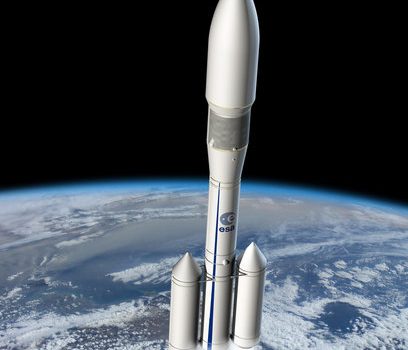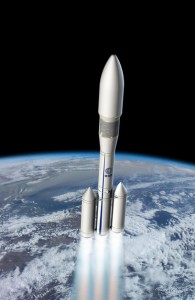

Artist’s conception of Ariane 6, with four identical solid engines, three for the first stage and one for the second stage. (Credit: ESA)
The European Space Agency (ESA) has finally decided the baseline design of Ariane 6, the next-generation launch vehicle that will succeed Ariane 5. According to the concept, the launch vehicle will have four solid-fueled boosters for the first and second stage, topped by a cryogenic third stage.
“This concept was selected after six months of trade-off studies done by a ‘plateau project’ integrating industrial teams working under ESA contract, consistent with Ministerial decisions” said a press release by ESA.
Ariane 6 is the result of the requests made by European ministers during the ESA’s Ministerial Council, held in Naples in November 2012. At the council, it was requested that a new launch vehicle should be capable of placing 3 to 6.5 tons into geostationary transfer orbit, thus decreasing the launch costs. A PPH configuration was chosen, to exploit the shared features with the cryogenic re-ignitable upper stage of Ariane 5 ME, currently in development by the French company Snecma. PPH indicates the sequence of stages used in the rocket: solid propulsion for the first and second stages, and cryogenic propulsion for the third stage.
Following the PPH configuration, a ‘Multi P linear’ concept was selected for Ariane 6. Three identical “in-line” solid boosters will compose Ariane 6’s first stage. A fourth solid motor will be mounted above, as second stage. Each of these boosters will be loaded with around 135 tons of solid propellant. The cryogenic upper stage will be equipped with a Vince engine and a 5.4 meter diameter payload fairing will accommodate the same volume of cargo as Ariane 5.
Although less capable than the heavy-lift Ariane 5, Ariane 6 is designed to be more affordable to produce and operate. The configuration’s choice was driver by three main criteria: exploitation costs, time to market and development costs.
In early June, ESA rejected the criticism moved by the Air and Space Academy regarding the selection of solid engines for the first and second stage. According to ESA, this solution will provide synergies with the Vega evolution perspectives.
ESA will soon issue a request for information to European industry on key work packages of the new launch system and the industry will have the maximum flexibility for meeting the requirements. This stage will be followed by more formal requests for bids on the new launcher’s components with a final decision expected in late 2014.

















































































































![A trajectory analysis that used a computational fluid dynamics approach to determine the likely position and velocity histories of the foam (Credits: NASA Ref [1] p61).](https://www.spacesafetymagazine.com/wp-content/uploads/2014/05/fluid-dynamics-trajectory-analysis-50x50.jpg)



Leave a Reply